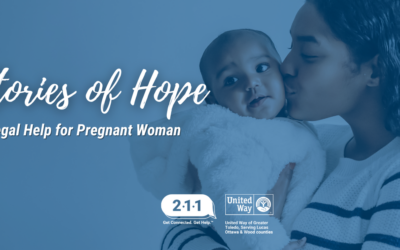Ohio is one of 28 states where childcare can amount to the equivalent of in-state college tuition. Let that sink in for a second.
Individuals right here in our community are struggling to pay their rent or mortgage, keep the utilities on, purchase food, put gas in their car and, oh, make sure to save for their retirement too…on top of juggling being a professional, working parent.
These are individuals seeking to place their child in the best, highest quality care they can while at work. After all, this time in their infant or toddler’s life is the most critical point in their long-term educational development.
Traumatic events, like the pandemic we are witnessing today, can both create, and reveal, new and existing disparities in the community. To repeat the words of a U.S. Senator who sat-in on a recent call with United Way, “COVID-19 has been a great revealer.”
Historical context and instances like the 2008 market crash and Federal Government closures in 2019 illuminate (in the most unfortunate way) those who are living paycheck to paycheck and have unfair, constrained economic mobility due to their race, ethnicity, gender expression, sexual orientation, etc. Showing us that negative actions, and their reactions, do not occur in silos – they often shock and hurt those who are most-vulnerable in the community.
On paper, our economy may be “rebounding” and unemployment rates slowly decreasing for the time being. But, as we have seen, it takes the average American household years to financially recover from lost wages and collapsed markets.
In a 2018 article, CBS News noted that, since the ‘08 market crash, “Ten years on, many Americans still bear the scars of the crisis. Some never regained the wealth they lost in the stock market and real estate…One-third of Americans with household income below $50,000 – or lower than the typical U.S. household – say they had not yet begun to recover…”
COVID-19 has impacted every sector across the American economic spectrum. An especially fragile industry is on the brink of collapsing, right now, amid this pandemic: Childcare.
Groundwork Ohio, the state’s leading policy and advocacy organization for children says that, “In Ohio, 556,558 children under age six have all available parents in the labor force.” Parents of nearly 600,000 kids are working, valuable and essential contributors to our local economies and communities.
For these folks to work, they need access to affordable childcare, within a reasonable proximity of their home.
Right now, numerous providers in Northwest Ohio are making the tough decision to either reopen or evaluate how long they can indeed stay open during this pandemic. Financial losses due to months-long closures, smaller class sizes, and new operation and cleaning protocols to keep staff and children safe, is proving to be a great challenge.
And let’s be clear: Opening a daycare or early learning facility is not a “get rich game.” Many providers operate on a (less than) one percent profit margin. These are individuals who are passionate about their work and want to serve children in their neighborhoods.
Some providers have received SBA (small business administration) loans or even direct dollars from the CARES Act. Though they are grateful for the few thousand dollars leveraged – it’s not enough to withstand this economic storm.
We cannot overlook childcare as a critical component of sustaining Northwest Ohio’s workforce and financial health.
Not to get too elementary…but it is basic economics of supply and demand. If mass-numbers of providers make the decision to close, that creates finite access to robust, quality childcare that all kids and parents deserve.
For centers who can stay open: Smaller classrooms, with already limited staff, creates an inflation in tuition costs and limited available openings for enrollees. Meaning that some parents may be placed on waiting lists and / or face severe cost increases, which poses the daunting question: Can I afford to go back to work?
Groundwork Ohio also estimates that we “…stand to lose 45% of our state’s childcare supply, which translates to nearly 100,000 slots across the state.” A loss of childcare openings means that more children in Ohio will automatically be out of care.
But COVID-19 and its direct impact on childcare goes even deeper than that.
A lack of childcare resources impacts both rural and metro-areas alike. Through this interactive map, we can see the disparity of existing childcare deserts across Lucas, Wood and Ottawa County. More centers closing only worsens this issue.
In a July article from Vox, in our “pre-COVID economy,” a lack of childcare resources was the equivalent to a five percent pay-cut for parents who had to either provide care for their children themselves or find care. In a study from the Center for American Progress, “…access to consistent and affordable high-quality early care and education accomplishes two important objectives: It promotes healthy child development, and it allows parents to work or to re-enter the labor force…”
Vox also notes that, by late June of this year, “13 percent of parents had cut back hours or quit their jobs” after limited access to childcare resources, closing daycares and closing early learning centers.
Given my statement above on the unreal, collegiate-like costs of care: We are pressuring providers to supply higher quality services, and, unlike other educational systems, receive little to no help from our government entities, which only increases their overall rates.
(With that, I of course want to make the disclaimer that our K-12 schools, teachers and administrators are not swimming in dollars by any means. And they too carry their own struggles in striving to provide a quality public education for students, with their own limited state / federal dollars).
Fortunately, this month, we at United Way, along with community advocates and volunteers were able to take personal calls from our federally elected officials: Senator Brown, Representative Kaptur and Representative Latta. We were also able to talk with a few policy staffers from Senator Portman’s office, stressing the importance that we must place on early childcare in the next COVID-19 stimulus package, as well as in future education-related policies.
We ask that you join us in our call for $50 billion in childcare relief by supporting the Child Care Is Essential Act, proposed in both the House and Senate. Money would be used to help childcare providers continue (temporarily) providing affordable, high-quality care, while also implementing important new health and safety measures.
Wall Street will bounce-back from the COVID-19 pandemic, but are we going to let the financial security of American households become so tattered that they must wait another 10 or more years to “bounce-back” too? Reducing hours and leaving a job to care for a child impacts the entire financial security of a person’s home. Especially for minority Americans, who already statistically earn lower wages than their white peers, despite having equivalent degrees or professional experience.
Please join United Way of Greater Toledo in shedding light on this issue. Help be a voice for working parents and our children who deserve safe, high-quality, educational care.
*UPDATE: On Jul. 29, the U.S. House of Representatives passed the Child Care is Essential Act with bi-partisan support. The same piece of legislation still sits as “introduced” in the U.S. Senate. Please continue to advocate to our federally elected officials on this important matter, especially as Congress debates the next COVID-19 economic relief / response package.
This post was written by Lucas Camuso-Stall, Sr. Director of Public Relations & Advocacy at United Way of Greater Toledo






















